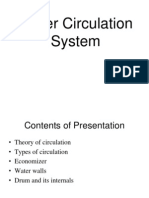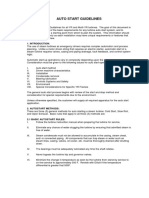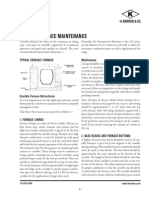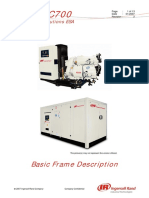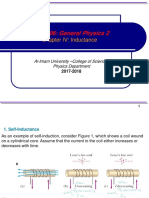Flame Impingment
Flame Impingment
Uploaded by
idigitiCopyright:
Available Formats
Flame Impingment
Flame Impingment
Uploaded by
idigitiOriginal Description:
Copyright
Available Formats
Share this document
Did you find this document useful?
Is this content inappropriate?
Copyright:
Available Formats
Flame Impingment
Flame Impingment
Uploaded by
idigitiCopyright:
Available Formats
FLAME IMPINGMENT
How docs the furnace provide for proper combustion? A For fuel to be burned efficiently, the furnace must have adequate combustion space to ensure a thorough mixing of air and fuel. The furnace must also maintain a high enough temperature for complete combustion. The furnace must be tight so that air cannot leak into, or out of, the casing and thus affect the air/fuel ratio. Too high a furnace temperature must also be avoided, as this can lead to rapid deterioration of linings (if installed), or possible overheating of vital pressure parts such as tubes or combustion furnaces in scotch marine boilers. Also, the reaction of combustion should be completed before the flue gases leave the combustion chamber so as to avoid flame impingement on tubes and possible overheating List the precautions needed with refractories on oil-fired boiicrs. A Refractories (brickwork) are subject to damage from many causes, such as improperly adjusted fires and vanadium-contaminated oil. Impingement and the resulting carbon buildup arc common. The flame should travel down the furnace on sm boiicrs without touching cither the furnace or the refractory. Long periods of operation on low firing often cause refractor)' damage. The very small flame reduces the combustion chamber temperature and causes poor combustion. Carbon builds up and intense heat is directed at the surface of the refractory, thus causing spalling (facing breaks off). Unless the oil has been specifically treated, there is no relief from the damages caused by vanadium in the oil. Moisture trapped in the refractory may develop steam, which ruptures the surface. Q What checks are made on the fireside of boilers? A Carefully inspect the plate and tube surfaces that are exposed to the fire. Look for places that might become deformed by bulging or blistering during operation. Solids in the waterside of lower generating tubes cause blisters when sludge settles in tubes and water cannot carry away heat. Urheberrechllich geschutzlcs Material Maintenance, Impaction, and Repair 313 Tiie boiler must be taken out of service until the defective part or parts have been properly repaired. Blistered tubes usually must be cut out and replaced with new. Lap-joint boilers are apt to crack where plates lap in a longitudinal or straight seam. If there is evidence of leakage or trouble at this point, remove the rivets and examine the plate'carefully if cracks exist in the seam. Cracks in shell plates are usually dangerous, except fire cracks that tun from the edge of the plate into the rivet holes of girth seams. Usually,
a limited number of such fire cracks are not very serious. Test stay bolts by tapping one end of each bolt with a hammer. For best results, hold a hammer or heavy tool at the opposite end while tapping. A broken bolt is indicated by a hollow sound. Tubes in hrt boilers deteriorate faster at the ends toward the fire. Tapping the outer surface with a light hammer shows if there is serious thinness. Tubes of vt boilers usually thin at the upper ends when exposed to the products of combustion. Lack of water cooling is the cause. Tubes subject to strong draft often thin from erosion caused by impingement of fuel and ash particles. Soot blowers, improperly used, will also thin the tubes. A leaky tube spraying hot water on nearby sooty tubes will corrode them seriously from an acid condition. Short tubes or nipple; joining drums or headers lodge fuel and ash, then cause corrosion if moisture is present. First clean, then thoroughly examine all such places. Baffles in wt boilers often move out of place. Then combustion gas, short -circuiting through baffles, raises the temperature on portions of the boiler, causing trouble. Heat localization from improper or detective burners, or operation causing a blowpipe effect, must be corrected to prevent overheating. What causes one or more bulges in tubes in a wt boiler? A Usually a piece of scale breaks away from inside the boiler and settles in a tube, causing localized overheating of tube metal (Fig 16-1). Flame or heat impingement and sludge deposits are also causes. If no evidence of scale is found after a tube bulges and leaks, it may have been blown free with the tube failure. Q Is flame impingement on boiler parts harmful? . local biiio- * Direct flame impingement causes local overin B (biiitar) on watoi heating of metal because water circulation may not , u b*- be fast enough to keep the metal within safe limits. On ci units, flame impingement can create uneven expansion stresses that may crack a section. On wt boilers, steam pockets can form in a tube, leading to tube bulging or rupturing
You might also like
- Chipping and Drilling ConcreteDocument2 pagesChipping and Drilling Concreteidigiti75% (12)
- Learn About Steam - Spirax SarcoDocument20 pagesLearn About Steam - Spirax SarcoGanesh KulalNo ratings yet
- RankineCycle Operator Manual PDFDocument72 pagesRankineCycle Operator Manual PDFMonique HepburnNo ratings yet
- Soot BlowersDocument36 pagesSoot Blowersarifullah100% (1)
- Boiler Emergencies - 2017Document10 pagesBoiler Emergencies - 2017RAJKUMAR100% (1)
- Boiler Questions BtechDocument5 pagesBoiler Questions BtechRishav Raj100% (1)
- Boiler MaintenanceDocument39 pagesBoiler MaintenanceAjay Chauhan100% (3)
- Boiler Furnace PDFDocument8 pagesBoiler Furnace PDFசுந்தர மூர்த்தி சேப்பிளையார்No ratings yet
- Boiler Inspection Tips 1Document146 pagesBoiler Inspection Tips 1Senake100% (1)
- Boiler Questions and AnswersDocument10 pagesBoiler Questions and AnswersAustin UdofiaNo ratings yet
- Report by KKParthiban On Boiler Explosion of A Shell Type High PR BoilerDocument97 pagesReport by KKParthiban On Boiler Explosion of A Shell Type High PR Boilerparthi20065768100% (2)
- Soot Blower Lance Tube CorrosionDocument11 pagesSoot Blower Lance Tube CorrosionMiguel Kühnert FrichenbruderNo ratings yet
- Boiler Pressure PartsDocument25 pagesBoiler Pressure PartsAnfal Barbhuiya100% (2)
- Boiler OperationDocument97 pagesBoiler Operationdeeli1100% (2)
- Cochran BoilerDocument5 pagesCochran Boilerpankaj chaudharyNo ratings yet
- Boiler Safety Program Boiler ProgramDocument8 pagesBoiler Safety Program Boiler Programsalman akbarNo ratings yet
- Water Circulation SystemDocument16 pagesWater Circulation SystemAkashKishoreNo ratings yet
- Draft Boiler and FurnaceDocument8 pagesDraft Boiler and FurnaceJayandi FitraNo ratings yet
- Lancashire BoilerDocument6 pagesLancashire BoilerNikhilesh BhargavaNo ratings yet
- Boiler Start Up ProceduresDocument8 pagesBoiler Start Up ProceduresamasrurNo ratings yet
- Supercritical Power Generation-Experiences, Issues & ChallengesDocument85 pagesSupercritical Power Generation-Experiences, Issues & ChallengesVeda Siddharth100% (1)
- FBC Boiler - OM ManualDocument35 pagesFBC Boiler - OM ManualSudhanshu PandeyNo ratings yet
- High Pressure Boilers PDFDocument38 pagesHigh Pressure Boilers PDFgokul virat100% (1)
- Boiler QuestionsDocument14 pagesBoiler QuestionsLamheNo ratings yet
- Energy Auditors 2 6 FBC BoilerDocument13 pagesEnergy Auditors 2 6 FBC Boilervij2009100% (1)
- What Is The Meaning of Marine Boilers ?Document11 pagesWhat Is The Meaning of Marine Boilers ?RachitNo ratings yet
- BoilerDocument205 pagesBoilerTarek Ahmed100% (3)
- Boiler EmergenciesDocument15 pagesBoiler EmergenciesAmit Chauhan100% (1)
- Boilers: - Asit MondalDocument29 pagesBoilers: - Asit MondalAJITSPATILNo ratings yet
- Explosion Occurance in CFBC Boiler and Necessary OperationsDocument6 pagesExplosion Occurance in CFBC Boiler and Necessary OperationsAnudeep ChittluriNo ratings yet
- For BoilerDocument71 pagesFor BoilerSonal PotdarNo ratings yet
- ALFA LAVAL Compact Heat Exchangers in HVAC SystemsDocument27 pagesALFA LAVAL Compact Heat Exchangers in HVAC SystemsvickersNo ratings yet
- Boiler Tube Failure and ImpactsDocument8 pagesBoiler Tube Failure and ImpactsUdhayakumar VenkataramanNo ratings yet
- Pressurised Deaerator Solutions-Sales BrochureDocument4 pagesPressurised Deaerator Solutions-Sales BrochureYury Lorenz100% (1)
- Spcer TubesDocument3 pagesSpcer TubesTapan GhongadeNo ratings yet
- BoilerDocument28 pagesBoilerHassan Funsho AkandeNo ratings yet
- The Dead Weight Safety Valve Consists of A ValveDocument4 pagesThe Dead Weight Safety Valve Consists of A ValveAsif Saleem0% (1)
- Installation and Maintenance Manual: Blowdown VesselsDocument28 pagesInstallation and Maintenance Manual: Blowdown Vesselsdaboo sanatNo ratings yet
- Boiler Tube LeakageDocument10 pagesBoiler Tube LeakagebajrangNo ratings yet
- Kerala BOE-2014 Paper-1 SolutionDocument10 pagesKerala BOE-2014 Paper-1 SolutionKiran GayakwadNo ratings yet
- Cold Start Boiler of LoosDocument2 pagesCold Start Boiler of LoosOA Aoo100% (1)
- Safety Valve Setting BoilerDocument2 pagesSafety Valve Setting BoilerkrishnaNo ratings yet
- Auto Start GuidelinesDocument7 pagesAuto Start GuidelinesBabar Priyadi Mugi Hanggana100% (1)
- Boiler Mounting and AccessoriesDocument20 pagesBoiler Mounting and AccessoriesAshok Joshi92% (12)
- Supercritical Technology in BoilersDocument17 pagesSupercritical Technology in BoilersKARTHIGEYAN.R100% (1)
- Manual On Boiler Tube FailureDocument69 pagesManual On Boiler Tube Failureyogeshmangal1974100% (2)
- Boiler Tube Failure PDFDocument8 pagesBoiler Tube Failure PDFmhd_bashiriNo ratings yet
- Boilers: by M.Rajasekara BabuDocument29 pagesBoilers: by M.Rajasekara BabuMuthu KumarNo ratings yet
- Boiler Hydro Test-StepsDocument6 pagesBoiler Hydro Test-StepsAbdul Gafoor Shaikh100% (1)
- Standard Erection Manual (Boiler Auxiliaries) PDFDocument222 pagesStandard Erection Manual (Boiler Auxiliaries) PDFharpreetresearchNo ratings yet
- Steam Circulation System of Pulverized Coal Fired Boiler.Document36 pagesSteam Circulation System of Pulverized Coal Fired Boiler.Rupesh Anand100% (1)
- AP BOE-2013 Paper-1 SolutionDocument9 pagesAP BOE-2013 Paper-1 SolutionAlok Doshi50% (2)
- Boiler Inspection in FurnaceDocument4 pagesBoiler Inspection in FurnacekrishnaNo ratings yet
- Causes of Deterioration in Fired Boilers-JnmDocument3 pagesCauses of Deterioration in Fired Boilers-JnmVishal BailurNo ratings yet
- Problem in BoilerDocument8 pagesProblem in Boileraadarsh kumarNo ratings yet
- Cracking of Boiler TubesDocument8 pagesCracking of Boiler Tubeslambu_ladNo ratings yet
- Scotch BoilerDocument52 pagesScotch Boilerrajishrrr100% (1)
- Cracking in Fire Tube BoilersDocument8 pagesCracking in Fire Tube BoilersRui AlexandreNo ratings yet
- Furnace MaintenanceDocument3 pagesFurnace MaintenanceTravis WoodNo ratings yet
- IMPORTANT Boiler Repairs Problems Marine Education MarineexamDocument8 pagesIMPORTANT Boiler Repairs Problems Marine Education MarineexamEge CNo ratings yet
- Fire Tube Master Boiler Inspection Pesintation 030622R1Document51 pagesFire Tube Master Boiler Inspection Pesintation 030622R1mehrdadNo ratings yet
- C700 - Basic Frame DescriptionDocument13 pagesC700 - Basic Frame Descriptionidigiti100% (1)
- Click The Chevron To Advance.: LION (Panthera Leo)Document5 pagesClick The Chevron To Advance.: LION (Panthera Leo)idigitiNo ratings yet
- Confined Space Rescue Plan: Description of The WorkDocument2 pagesConfined Space Rescue Plan: Description of The Workidigiti100% (1)
- Pump NPSH Calculation: ValueDocument1 pagePump NPSH Calculation: ValueidigitiNo ratings yet
- Electromagnetic Field: Jump ToDocument9 pagesElectromagnetic Field: Jump ToidigitiNo ratings yet
- Transformer: Navigation SearchDocument18 pagesTransformer: Navigation SearchidigitiNo ratings yet
- Energy Savings From Steam Losses On An Oil RefineryDocument11 pagesEnergy Savings From Steam Losses On An Oil RefineryidigitiNo ratings yet
- Oilrefinery MINASDocument2 pagesOilrefinery MINASidigitiNo ratings yet
- Current Transformer MeasurementsDocument4 pagesCurrent Transformer MeasurementsidigitiNo ratings yet
- Peter Phelps, Jr. Phelps Engineering Company Laguna Niguel, CaliforniaDocument15 pagesPeter Phelps, Jr. Phelps Engineering Company Laguna Niguel, CaliforniaidigitiNo ratings yet
- Electrical Impedance: Electrical Impedance, or Simply Impedance, Is A Term Coined byDocument8 pagesElectrical Impedance: Electrical Impedance, or Simply Impedance, Is A Term Coined byidigitiNo ratings yet
- CR Magnetics Sensing SolutionsDocument2 pagesCR Magnetics Sensing SolutionsidigitiNo ratings yet
- Onload Boiler Cleaning SystemDocument11 pagesOnload Boiler Cleaning SystemidigitiNo ratings yet
- Vertical Turbine Pumps Oil N Water Lubricated PDFDocument6 pagesVertical Turbine Pumps Oil N Water Lubricated PDFidigitiNo ratings yet
- Oilrefinery MINASDocument2 pagesOilrefinery MINASidigitiNo ratings yet
- PC 3 2005 Mohamadbeighy2 FinalDocument6 pagesPC 3 2005 Mohamadbeighy2 FinalidigitiNo ratings yet
- Case Studymajor Chemical Disasters FILEminimizerDocument73 pagesCase Studymajor Chemical Disasters FILEminimizeridigitiNo ratings yet
- S 001 Link 2Document1 pageS 001 Link 2wael badawiNo ratings yet
- MCQS CH #3 - 1234Document7 pagesMCQS CH #3 - 1234Faisal IqbalNo ratings yet
- Model:: AE4425Y-GS1ADocument8 pagesModel:: AE4425Y-GS1AEvandro Jva compressoresNo ratings yet
- SB 32Document2 pagesSB 32Harrier ESNo ratings yet
- EMAG - Eldec - ECO-LINE - US BOLT HEATERDocument4 pagesEMAG - Eldec - ECO-LINE - US BOLT HEATERBahim BahimanNo ratings yet
- 7.17.5 Calculation of Short-Term Deflection: I I I I - M / M) (Z / D) (X/D) (B/B) IDocument1 page7.17.5 Calculation of Short-Term Deflection: I I I I - M / M) (Z / D) (X/D) (B/B) IscrNo ratings yet
- JAN 24 Batch: Pre Mock - 02Document3 pagesJAN 24 Batch: Pre Mock - 02Quazi Sahil HossainNo ratings yet
- Modeling The Uniformity of Manifold With Various ConfigurationsDocument17 pagesModeling The Uniformity of Manifold With Various Configurationse.vicente.caballeroNo ratings yet
- Chapter 2 Chemical Basis in LifeDocument38 pagesChapter 2 Chemical Basis in LifeMakiato MaureenNo ratings yet
- Brick CastingDocument6 pagesBrick Castingericknyakundi009No ratings yet
- Lecture18 Directionalvalvesandsymbols 190826041520Document17 pagesLecture18 Directionalvalvesandsymbols 190826041520pavan potluriNo ratings yet
- UC3848Document12 pagesUC3848isaiasvaNo ratings yet
- Btech 2 Sem Engineering Mathematics 2 Kas203t 2022Document2 pagesBtech 2 Sem Engineering Mathematics 2 Kas203t 2022Shivam SinghNo ratings yet
- Microsoft Word - Stand Alone System Sizing Procedure W-Charts and BlankDocument13 pagesMicrosoft Word - Stand Alone System Sizing Procedure W-Charts and BlankMidah SallehNo ratings yet
- Recrystallization Mechanisms and Microstructure Development inDocument15 pagesRecrystallization Mechanisms and Microstructure Development invibeunguNo ratings yet
- AQS-KAM-xx, AQS 71-KAM-T, AQS-KAM-RH-V: Co2 Temperature Humidity TransmittersDocument4 pagesAQS-KAM-xx, AQS 71-KAM-T, AQS-KAM-RH-V: Co2 Temperature Humidity TransmittersAnonymous XYAPaxjbYNo ratings yet
- Technical Proposal Calcium Ammonium Nitrate (Can) Plant Pakarab - PakistanDocument22 pagesTechnical Proposal Calcium Ammonium Nitrate (Can) Plant Pakarab - PakistanAtif MasoodNo ratings yet
- Phys 106: General Physics 2: Chapter IV: InductanceDocument63 pagesPhys 106: General Physics 2: Chapter IV: InductancehwuhwuheNo ratings yet
- Guo 2005Document16 pagesGuo 2005Taha SerwerNo ratings yet
- Chaudhry 2008Document12 pagesChaudhry 2008filipecorsairNo ratings yet
- Littelfuse Thyristor C106 D Datasheet PDFDocument5 pagesLittelfuse Thyristor C106 D Datasheet PDFExodia RaNo ratings yet
- Method For Range Calculation Based On Empirical Models of Proton in Liquid Water Validation Study by Other Monte Carlo Platform and ICRU DataDocument9 pagesMethod For Range Calculation Based On Empirical Models of Proton in Liquid Water Validation Study by Other Monte Carlo Platform and ICRU DataAndree PopaNo ratings yet
- Thus, The Velocity of The Exhaust Gas Is: MethaneDocument19 pagesThus, The Velocity of The Exhaust Gas Is: Methaneyogeshkumar3089_8250No ratings yet
- Catalog Linear Axis KK enDocument48 pagesCatalog Linear Axis KK enMikel IglesiasNo ratings yet
- Bio Chemical Separation Assignment No. 4Document3 pagesBio Chemical Separation Assignment No. 4Nikhil TanwarNo ratings yet
- 50x50x5mm Angle Section DesignDocument3 pages50x50x5mm Angle Section DesignNadir Khattak Jr.No ratings yet
- Aa19721 03Document5 pagesAa19721 03baskaran.marieNo ratings yet
- Filters in Control Systems: Figure 1 Passive Low-Pass Filter Circuit DiagramDocument5 pagesFilters in Control Systems: Figure 1 Passive Low-Pass Filter Circuit Diagramahmet şahinNo ratings yet
- Prof. Suren's Notes On Optical FibresDocument11 pagesProf. Suren's Notes On Optical FibresYo azharNo ratings yet
- Chap 02 HW - Atomic StructureDocument18 pagesChap 02 HW - Atomic StructureEUNAH Lim100% (1)
















